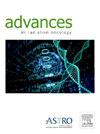利用铅笔束扫描技术对无法切除的骶尾部脊索瘤患者进行调强碳离子放射治疗
IF 2.2
Q3 ONCOLOGY
引用次数: 0
摘要
目的 探讨利用铅笔束扫描技术对无法切除的骶尾部脊索瘤(SC)患者进行调强碳离子放射治疗(IM-CIRT)的安全性和有效性。在68.6%(24/35)的病例中,肿瘤位于S2或以上,所有病例都接受了低分次IM-CIRT治疗。中位剂量为 70.4 Gy(范围为 69-80 Gy)(相对生物有效性),分 16 次(范围为 16-23 次)进行,通常每周分 5 次给药。结果在中位随访时间为 42 个月(范围为 12-91 个月)的整个队列中,3 年总生存率、病因特异性生存率、无进展生存率、局部无进展生存率和无远处转移生存率分别为 93.2%、96.3%、61.8%、80% 和 77.3%。多变量分析显示,肿瘤总体积(危险比,3.807;95% CI,1.044-13.887;P = .043)是无进展生存期的唯一显著预后因素,肿瘤总体积≥70.4 Gy(相对生物有效性)的剂量与显著改善的局部无进展生存期相关(危险比,0.190;95% CI,0.038-0.940;P = .042)。总生存期、病因特异性生存期和无远处转移生存期均无明显预后因素,也未发现严重(即≥3级)急性毒性。3名患者(8.57%)出现了严重的晚期毒性:疼痛(1名患者)、运动神经病变(1名患者)和皮肤溃疡(1名患者)。此外,IM-CIRT 治疗后未观察到与排尿功能或排便有关的严重毒性。结论IM-CIRT可产生可接受的3年疗效,无严重的后期不良反应,尤其是SC的泌尿和肛门直肠并发症,而且似乎不会增加疼痛。采用低分次放射治疗的大剂量 IM-CIRT 可改善局部控制效果,即使是术后复发的 SC 也似乎可行。本文章由计算机程序翻译,如有差异,请以英文原文为准。
Intensity Modulated Carbon Ion Radiation Therapy Using Pencil Beam Scanning Technology for Patients With Unresectable Sacrococcygeal Chordoma
Purpose
To investigate the safety and efficacy of intensity modulated carbon ion radiation therapy (IM-CIRT) using pencil beam scanning technology for patients with unresectable sacrococcygeal chordoma (SC).
Methods and Materials
A total of 35 patients with unresectable SC were retrospectively analyzed, including 54.3% (19/35) recurrent cases. In 68.6% (24/35) cases, tumor was located in S2 or above, and all cases were treated with hypofractionated IM-CIRT. The median dose was 70.4 Gy (range, 69-80 Gy) (relative biologic effectiveness) in 16 fractions (range, 16-23 fractions), typically delivered over 5 fractions per week.
Results
The 3-year overall survival, cause-specific survival, progression-free survival, locoregional progression–free survival, and distant metastasis–free survival rates with a median follow-up time of 42 months (range, 12-91 months) for the entire cohort were 93.2%, 96.3%, 61.8%, 80%, and 77.3%, respectively. Multivariate analysis revealed that gross tumor volume (hazard ratio, 3.807; 95% CI, 1.044-13.887; P = .043) was the only significant prognostic factor for progression-free survival and the dose for the gross tumor volume ≥70.4 Gy (relative biologic effectiveness) was relevant with significantly better locoregional progression–free survival (hazard ratio, 0.190; 95% CI, 0.038-0.940; P = .042). No significant prognostic factor for overall survival, cause-specific survival, and distant metastasis–free survival and no severe (ie, grade ≥3) acute toxicity were identified. Severe late toxicities occurred in 3 patients (8.57%): pain (1 patient), motor neuropathy (1 patient), and skin ulcer (1 patient). Furthermore, no severe toxicity related to urinary function or defecation was observed following IM-CIRT. Pain grades improved or remained unchanged in 85.7% of patients.
Conclusions
IM-CIRT produced acceptable 3-year outcomes without substantial late adverse effects, especially urinary and anorectal complications for SC, and did not appear to increase pain. IM-CIRT at high doses using hypofractionated radiation therapy may improve outcomes for local control and seems to be feasible even for postoperative recurrent SC.
求助全文
通过发布文献求助,成功后即可免费获取论文全文。
去求助
来源期刊

Advances in Radiation Oncology
Medicine-Radiology, Nuclear Medicine and Imaging
CiteScore
4.60
自引率
4.30%
发文量
208
审稿时长
98 days
期刊介绍:
The purpose of Advances is to provide information for clinicians who use radiation therapy by publishing: Clinical trial reports and reanalyses. Basic science original reports. Manuscripts examining health services research, comparative and cost effectiveness research, and systematic reviews. Case reports documenting unusual problems and solutions. High quality multi and single institutional series, as well as other novel retrospective hypothesis generating series. Timely critical reviews on important topics in radiation oncology, such as side effects. Articles reporting the natural history of disease and patterns of failure, particularly as they relate to treatment volume delineation. Articles on safety and quality in radiation therapy. Essays on clinical experience. Articles on practice transformation in radiation oncology, in particular: Aspects of health policy that may impact the future practice of radiation oncology. How information technology, such as data analytics and systems innovations, will change radiation oncology practice. Articles on imaging as they relate to radiation therapy treatment.
 求助内容:
求助内容: 应助结果提醒方式:
应助结果提醒方式:


